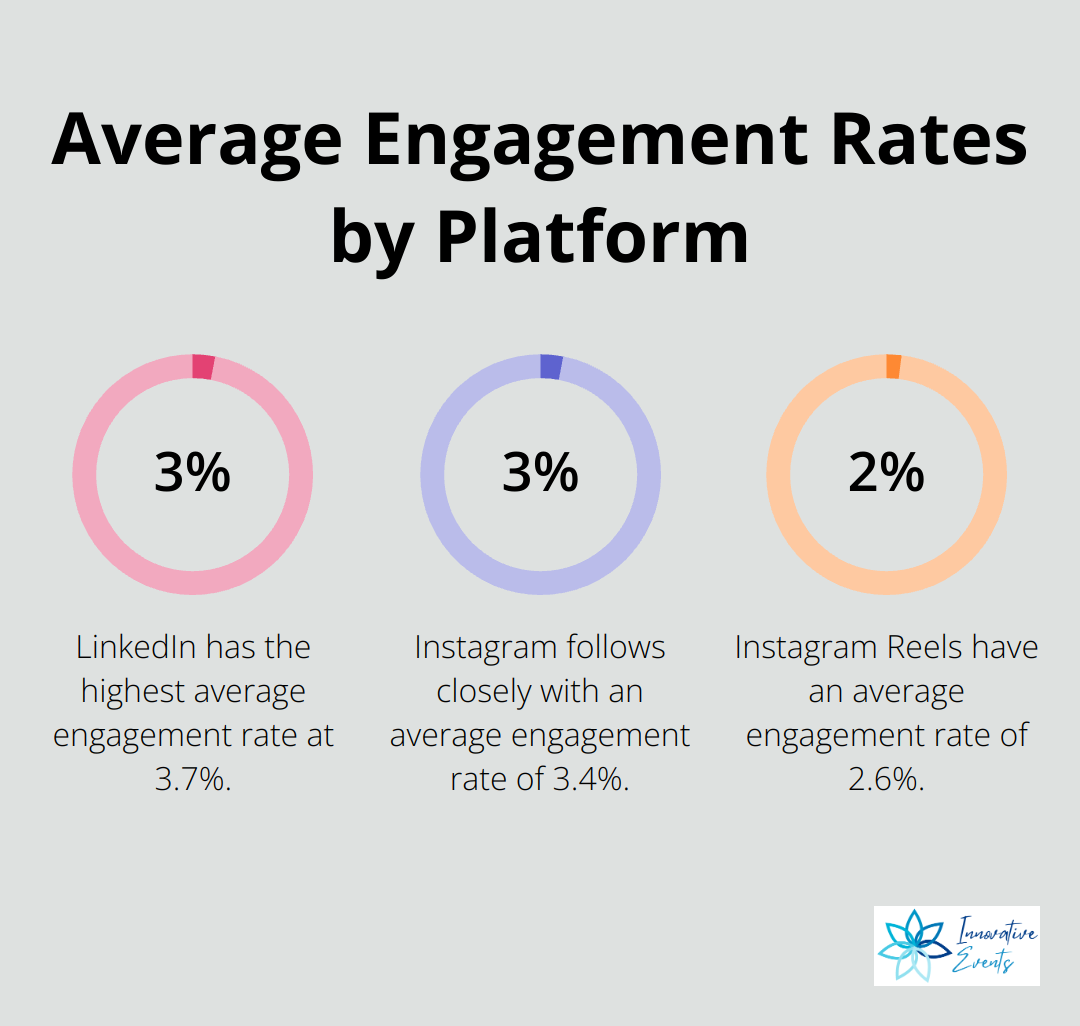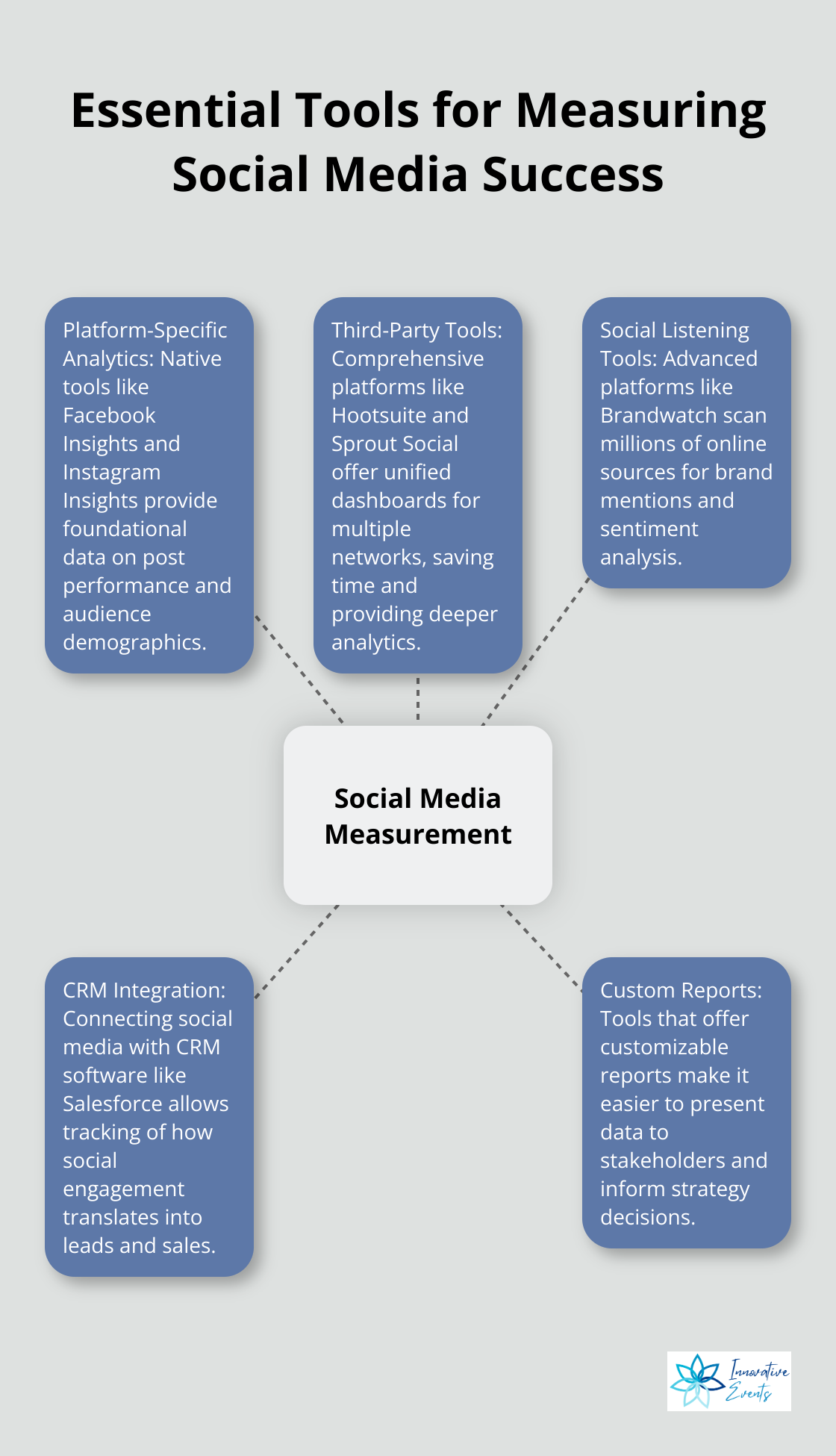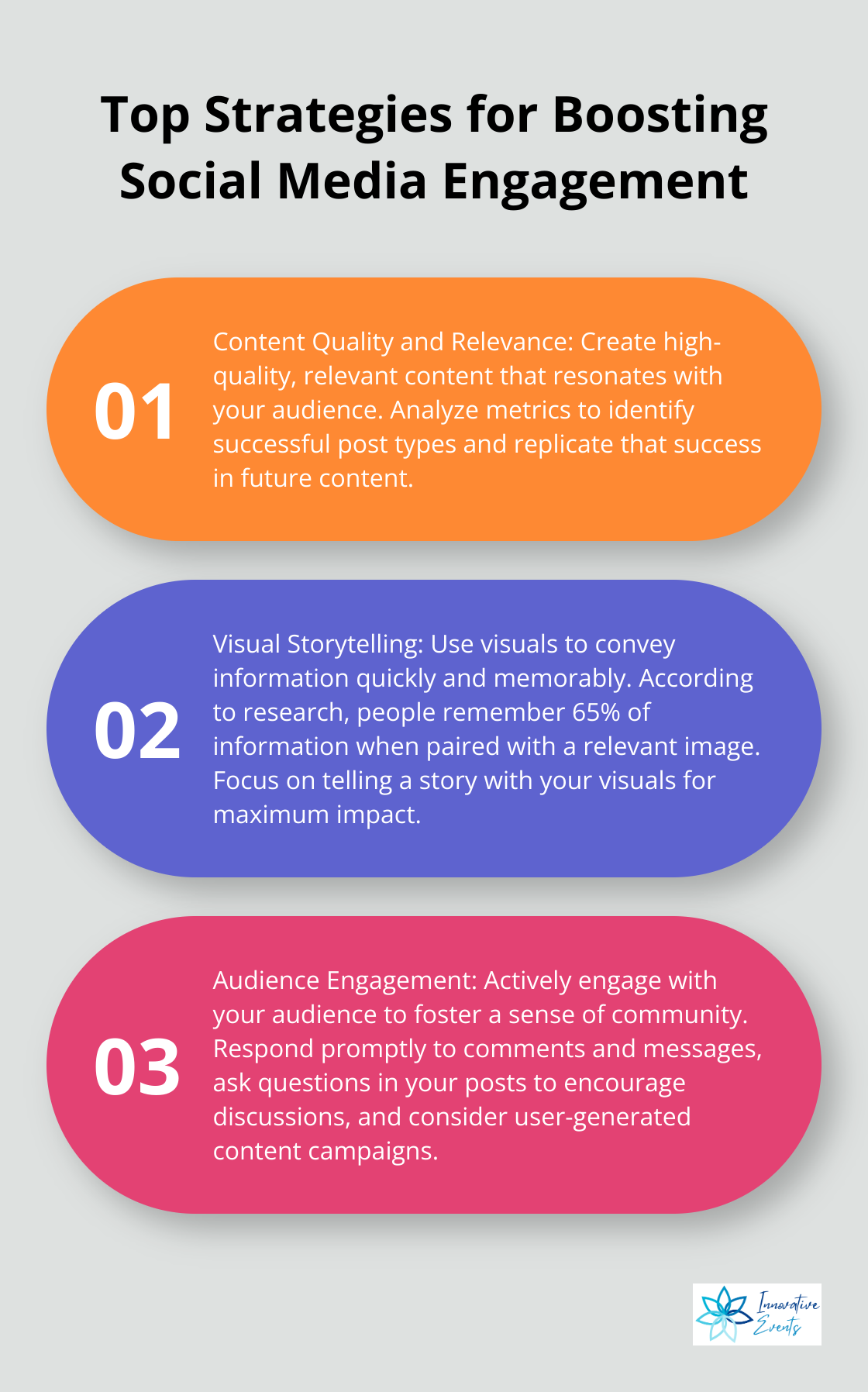Social media engagement metrics are the heartbeat of your online presence. They reveal how well your content resonates with your audience and guide your strategy.
At Innovative Events, we know that understanding these metrics is key to social media success. This post will break down the essential engagement metrics and show you how to measure them effectively.
Measuring Social Media Impact: Key Metrics for Success
Engagement Rate: The Gold Standard
Engagement rate stands as the gold standard of social media metrics. Calculate it by dividing total engagements (likes, comments, shares) by your total followers, then multiplying by 100. Recent data shows average engagement rates of 3.7% for LinkedIn, 3.4% for Instagram, 2.6% for Instagram Reels, and a lower rate for X (Twitter).

A high engagement rate often correlates with increased brand loyalty and customer retention. It’s not just about numbers; it’s about building a community that cares about your brand.
Click-Through Rate: Action Speaks Louder
Click-through rate (CTR) measures the percentage of people who click on a link in your post. It directly indicates how compelling your call-to-action is. According to industry data, the average CTR for Facebook ads across all industries is 0.90%. If you hit 1% or above, you outperform the average.
Reach and Impressions: Visibility Matters
Reach shows how many unique users saw your post, while impressions count the total number of times your post appeared. These metrics help you understand your content’s visibility. Industry studies suggest that the average reach for an organic Facebook post is about 5.2% of a page’s total likes. Consistent performance above this percentage indicates strong content visibility.
Follower Growth Rate: Building Your Base
Your follower growth rate indicates your brand’s health on social media. Calculate it by dividing new followers by total followers, then multiplying by 100. Recent data shows that the median follower growth rate for brands on Instagram is about 2.5% per month. Set your sights on beating this benchmark to stay ahead of the curve.
Mentions and Tags: Digital Word of Mouth
Mentions and tags represent modern word-of-mouth marketing. They show how often people talk about your brand. Use social listening tools to track these metrics. A sudden spike in mentions could indicate a viral moment or a potential crisis (both demand your immediate attention).
These metrics work together to paint a comprehensive picture of your social media performance. They don’t just boost numbers; they create meaningful connections with audiences. That’s the essence of effective social media strategy.
Now that we’ve covered the key metrics, let’s explore the tools that make measuring these metrics easier and more efficient.
Measuring Social Media Success: Essential Tools and Techniques
Platform-Specific Analytics: The Foundation
Each social media platform offers its own analytics dashboard. Facebook Insights, Instagram Insights, and Twitter Analytics provide valuable data on post performance, audience demographics, and engagement rates. These native tools form the foundation of any social media measurement strategy.
Facebook Insights displays your page’s reach, engagement rate, and follower growth. It also breaks down post performance, allowing you to see which content resonates most with your audience. Instagram Insights offers data on impressions, reach, and profile visits, helping you understand your content’s impact.
Comprehensive Third-Party Tools: The Power Players
Third-party tools offer more comprehensive insights than native analytics. Hootsuite, Sprout Social, and Buffer provide unified dashboards for multiple platforms, saving time and offering deeper analytics.
Hootsuite allows you to schedule posts, monitor mentions, and analyze performance across various social networks from a single dashboard. It also offers custom reports, making it easier to present data to stakeholders.
Sprout Social excels with its social listening capabilities, allowing you to track brand mentions and sentiment across the web. This broader perspective can inform your content strategy and help you respond quickly to customer feedback.

Advanced Social Listening: The Deep Dive
For businesses looking to understand brand perception and industry trends, social listening tools like Brandwatch or Mention prove invaluable. These platforms scan millions of online sources to provide insights on brand mentions, sentiment analysis, and competitor tracking.
Brandwatch offers real-time alerts for brand mentions, allowing you to respond quickly to customer inquiries or potential crises. It also provides in-depth reports on share of voice, helping you understand how your brand compares to competitors in online conversations.
CRM Integration: The Full-Funnel View
To truly understand the impact of social media on your business, integrate your social media with your Customer Relationship Management (CRM) software. Platforms like Salesforce and HubSpot offer social media integrations that allow you to track how social engagement translates into leads and sales.
This integration provides a full-funnel view of your marketing efforts. You can see which social media campaigns drive the most qualified leads and ultimately contribute to your bottom line. This data proves social media ROI and informs future marketing strategies.
The right combination of these tools (along with the expertise to interpret the data they provide) can transform your social media strategy. As we move forward, we’ll explore how to use these insights to improve your social media engagement and drive real business results.
Boosting Social Media Engagement: Proven Strategies That Work
Content Reigns Supreme: Quality and Relevance
A sharp social media strategy turns platforms like LinkedIn and X into powerful tools for building trust, sparking conversations, and driving conversions. B2B companies can position themselves as thought leaders by sharing industry insights and trend analyses.
To create truly relevant content, analyze your metrics. Identify posts with the highest engagement rates and replicate that success. If infographics consistently outperform other content types, allocate more resources to visual data representation.
Visual Storytelling: Conveying Information Quickly
Visual content conveys information quickly and memorably. According to a study mentioned in John Medina’s book “Brain Rules”, people remember 65% of information when paired with a relevant image.
Not all visuals have equal impact. Focus on telling a story with your visuals. A before-and-after image of a successful event can prove more powerful than a generic stock photo.
Optimal Timing: Maximizing Impact
Posting at strategic times can significantly boost engagement. These times vary by platform and audience.
Don’t rely solely on general statistics. Use your own analytics to determine when your specific audience shows the most activity. Many social media management tools offer features to automatically schedule posts at optimal times based on your audience’s behavior.
Consistency trumps frequency. Regular posting, even if limited to a few times a week, outperforms sporadic bursts of activity followed by long silences.
Audience Engagement: Building Meaningful Connections
Active engagement with your audience fosters a sense of community. Respond promptly to comments and messages. Ask questions in your posts to encourage discussions. User-generated content campaigns can boost engagement while providing authentic content for your brand.

Leveraging Trends: Staying Relevant
Stay attuned to current trends and incorporate them into your content strategy when relevant to your brand. This approach can increase your content’s visibility and engagement. However, ensure the trend aligns with your brand values and audience interests.
Final Thoughts
Social media engagement metrics provide essential insights into audience preferences and behaviors. We track these metrics to refine our content strategy, optimize posting schedules, and tailor messaging for maximum impact. High engagement rates strengthen brand loyalty, amplify reach, and drive conversions, while also signaling to algorithms that our content is valuable.
To implement effective measurement strategies, set clear, measurable goals aligned with your business objectives. Choose metrics that best reflect these goals and consistently track them using appropriate tools. Analyze your data regularly to identify trends and adjust your strategy as needed.
At Innovative Events, we apply data-driven approaches to create personalized, integrative lifestyle programs for busy executives. Our Ascent Concierge Health program helps clients achieve optimal performance and life balance. Try to master social media engagement metrics through continuous learning and adaptation to navigate the ever-evolving social media landscape effectively.

